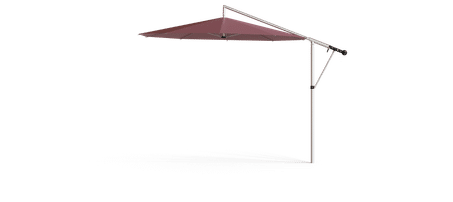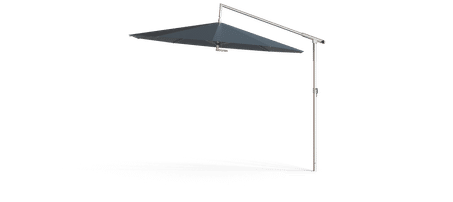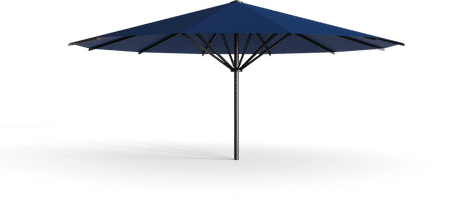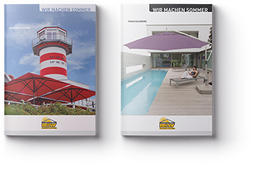Do parasols provide enough protection from UV light?
Germany’s consumer organisation ‘Stiftung Öko-Test’ put parasols and beach shelters to the test in 2008 to find out how much protection these products provide from UV radiation.
The outcome: Of a total of 38 beach shelters and parasols that were tested, nine of them only offered “inadequate”, and four “poor” UV protection. A number of sun protection products did, however, perform well: Ten parasols were awarded a grade of “very good” or “good”, while three were “satisfactory”. Glaring disparities like this, first and foremost, make consumers wonder how they are suppose to know which parasol provides adequate UV protection, and which product feature is responsible for ensuring a parasol provides good protection from UV radiation.
An optimal parasol should, in any case, satisfy a number of criteria
- It should be able to be tilted towards the sun or have a sufficient size (> 8' 2" to allow the UV protection to be adapted to any given position of the sun.
- In many cases, polyester provides better protection than cotton.
- Those who would like to be on the safe side should purchase a parasol that has been tested and certified in accordance with UV801. This is currently the strictest standard covering UV protection, with the parasol only being tested following intensive use. All fabrics that MAY uses are subject to the UV801 standard. More information about the UV801 standard can be found at the following link: www.uvstandard801.com/en
In addition, if a parasol is expected to provide years of shade, for example for guests at cafés and restaurants, there are even more factors to take into account
- Choose a particularly hardwearing and weather-resistant fabric to ensure the parasol can withstand the stress and strain placed on it.
- Straightforward opening and closing of parasols when there is wind or rain is possible when an optional tubular motor with wind sensor in combination with a home automation system is used.
The right choice of parasol also depends on a large number of factors when sufficient protection from UV light, on the one hand, and a robust and long-lasting product on the other hand are required. But as long as you’re aware of which criteria are important for you, you’ll be able to find the right parasol.
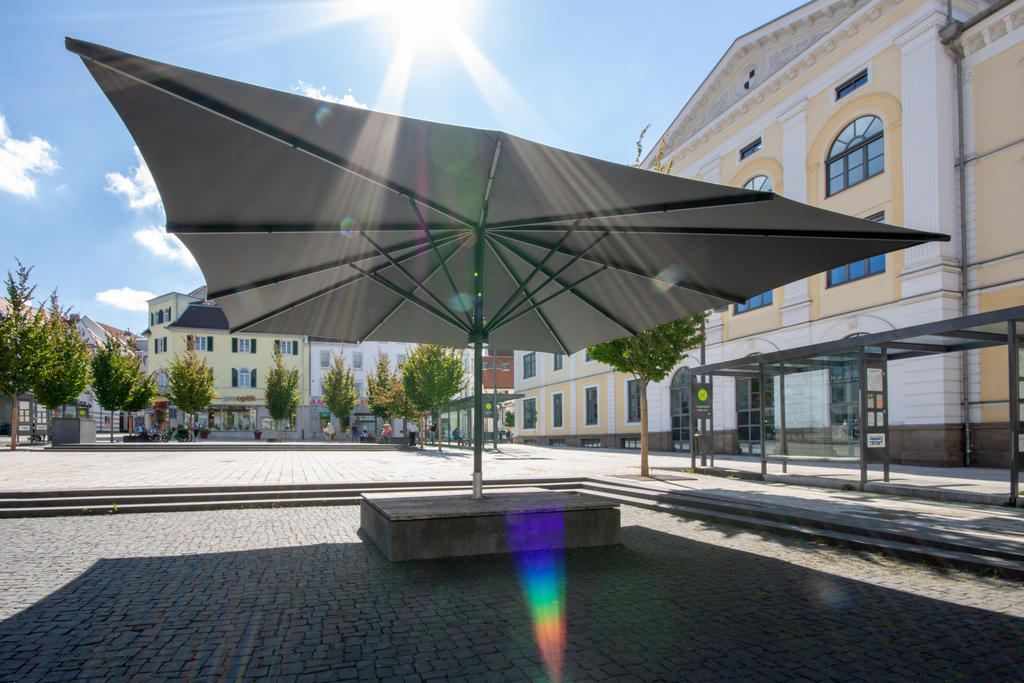
What is UV radiation and what effect does it have on people?
Ultraviolet radiation, or UV radiation for short, is electromagnetic radiation that is invisible to the human eye due to it having a wavelength that is shorter than the light spectrum that is visible to people.
Human skin is comprised of three layers: the epidermis, the dermis and the hypodermis. UV-A rays, which exhibit a wavelength from 315 to 380 mm, penetrate right through to the dermis. They cause direct pigmentation there, which is a darkening that only lasts a few hours and barely provides protection from the light. Moreover, they damage collagen, resulting in the skin losing elasticity and ageing prematurely and free radicals forming, which leads to a increased risk of melanoma. UV-A radiation, however, causes only a little sunburn.
UV-B radiation with its even shorter waves, in contrast, doesn’t just have harmful effects on the human body. Indeed, it allows vitamin D to be formed in the epidermis. This function of UV-B rays is not only essential for life, but actually helps prevent cancer. UV-B rays are also responsible for a long-term, delayed darkening of the skin that helps provide protection from light. They are, however, a major cause of sunburn and are considered the main cause of skin cancer.
The skin can protect itself from harmful UV radiation for a certain period of time. The skin’s intrinsic protection time varies from person to person, and depends an individual’s skin type. As a general rule, fair-skinned people can spend less time in the sun without having to fear damaging effects than people with darker skin and hair.
| Type | Characteristics | Reaction of unprotected skin to 30 minutes of sun exposure in June | Intrinsic protection time of the skin | Intrinsic protection time provided by the parasol | ||
|---|---|---|---|---|---|---|
| 1 | light skin, freckles, blonde or red hair, blue or green eyes | sunburn every time, no tan | 5 - 10 Minutes | 200 - 400 Minutes | 300 - 600 Minutes | 400 - 800 Minutes |
| 2 | light skin, blonde hair, blue or green eyes | sunburn every time, slight tan | 10 - 20 Minutes | 400 - 800 Minutes | 600 - 1200 Minutes | 800 - 1600 Minutes |
| 3 | dark hair, blue eyes | slight sunburn, good tan | 20 - 30 Minutes | 800 - 1200 Minutes | 1200 - 1800 Minutes | 1600 - 2400 Minutes |
| 4 | dark skin, dark or black hair, brown eyes | no sunburn, tan every time | approx. 45 Minutes | approx. 1800 Minutes | approx. 2700 Minutes | approx. 3600 Minutes |
| 5 | dark skin, black hair, dark eyes | no sunburn | approx. 60 Minutes | approx. 2400 Minutes | approx. 3600 Minutes | approx. 4800 Minutes |
| 6 | black skin, black hair, black eyes | no sunburn | approx. 90 Minutes | approx. 3600 Minutes | approx. 5400 Minutes | approx. 7200 Minutes |
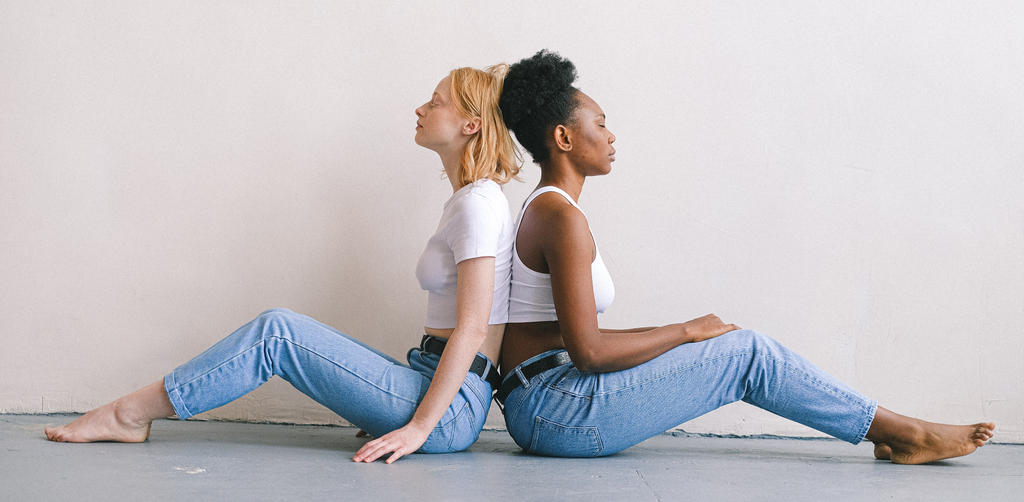
How can you protect yourself from harmful UV radiation?
There are different ways to protect yourself from harmful UV rays. In any case, not exposing yourself to the sun’s rays without protection is advisable to prevent long-term consequences – this primarily being skin cancer.
Sunscreens
Those who do spend time in the sun should make absolutely sure that they use a sunscreen with the highest possible light protection factor before going outside. In this case, it is extremely important to apply the sunscreen at the right time, which is well before going outside to sunbathe. Making liberal use of the sunscreen is equally important. Which light protection factor is chosen should be made dependent on the individual skin type along with a number of other factors, primarily where time will be spent in the sun, and for how long. Sunscreen products should only ever be used as a supplement to other measures – for example, protective clothing and spending the majority of time in the shade – because sunscreens do not filter out the entire spectrum of UV radiation. Also worth keeping in mind is that some ingredients used in sunscreens are not good for the skin.Source: German Federal Institute for Risk Assessment.
Clothing
Clothing is one of the oldest means that people use to protect themselves from solar radiation. Along with normal, everyday clothing, which in most cases allows some residual UV radiation to pass, there are also fabrics specially made to provide above-average UV protection. Small children, above all, should never spend time in the sun without protective clothing and sunscreen with a high light protection factor.
A head covering is also an essential means of protection. While hair does provide an exposed head with a certain level of protection from UV rays, wearing a wide-brimmed hat or a baseball cap is recommended to prevent sunburn and to protect the eyes as well.
Seeking shade
The most effective method of all to protect yourself from the damaging effects of solar radiation is staying in the shade. Of course, this won’t always be practicable – but in summer, it’s certainly worth avoiding the sun altogether when it’s midday
Humans started making sunshields, along with parasols, for this very purpose early on. The very first depictions of parasols were made in Egypt, Persia and China in ancient times. This makes the parasol considerably older than the umbrella. Initially, parasols were always carried around in the hand, a practice that is still customary today in a number of regions, such as Asia. Only in the 20th century were parasols on stands developed, the type now familiar to us from cafés, for example.
Our parasols
